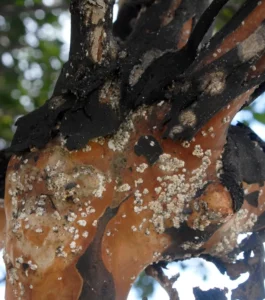
Crapemyrtle woes
Thanks to the University of Maryland/Maryland Grows this informative article about crapemyrtle woes.
Q: My crapemyrtle has white stuff on the bark that I’ve never noticed before, though the foliage looks unaffected, if a bit dull lately. I thought these plants were pretty pest-free, so what might this be?
A: We’ve had a lot of inquiries about this lately. Your plant has Crapemyrtle Bark Scale(CMBS), a non-native insect pest that was discovered in Texas in 2004. It was confirmed in Maryland in 2020. Incidentally, crapemyrtles also can host Crapemyrtle Aphid. And, it’s possible for the two to be infesting a plant simultaneously; their impacts on the plant are similar.

CMBS
While CMBS could potentially feed on other host plants, so far they seem to strongly prefer crapemyrtle. The aphid sticks to crapemyrtle. Both secrete honeydew, the sugar-water waste common to sap-feeding insects, which is dulling the leaf appearance and probably cultivating a bit of sooty mold.
Since mid-Atlantic gardeners have embraced crapemyrtle to such an extreme that it’s everywhere you look, that’s a big buffet enabling this pest proliferation. We really need to diversify our landscapes.
Scale insects lead relatively sedentary lives, generally only moving about to any notable degree as newborns, appropriately called crawlers. After roaming to find a feeding site, crawlers settle down and stay put, using their straw-like mouthparts to feed on plant juices. Layers of protective wax, in this case felt-like and white, cover their bodies as they mature. For our purposes, this also means they are harder to treat with contact-type insecticides like oils or soaps because that shell prevents the pesticide from reaching them. Crawlers, running around shell-less for that brief window of time, are the most vulnerable life stage any treatment should focus on.
The problem is, this pest is so new to our area that we are still collecting data on when those crawlers appear. Insect development is dependent on temperature. While we can make predictions based on how CMBS behaves to our south, we’re still refining our knowledge for Maryland. Complicating matters is the likelihood of several generations per year, and they might overlap.
How did it get there?
For such a tiny thing with limited mobility, you may wonder how it got there in the first place. Like plant mites, crawlers can blow around on the wind. They might also disperse by hitching a ride on other animals, like birds. CMBS arrived in our area the way many plant pests do – accidental introduction on plants with undetected infestations shipped-in from out of the area.
Management of an established scale population, usually booming by the time we notice them, takes time. Don’t expect one or two treatments to resolve the issue quickly. You’ll probably need to employ the services of a certified pesticide applicator. Manually scrubbing scale off while not wounding bark is difficult and not highly effective. This is due to the nooks and crannies they can wedge themselves into that you cannot reach.
Not only should certified applicators treat trees too high to reach, but they will have more effective equipment and the ability to apply chemicals the general public cannot due to the Maryland pollinator protection law. Overlapping the use of more than one type of pesticide may be needed, and re-treatment might occur for over a year. Dead scale won’t fall off right away, though treatments for scale will probably suppress aphids at the same time.
Pesticide treatment
While we usually suggest trying other methods to suppress pests, once scale are numerous, there is little recourse than resorting to pesticide treatment. Certain species of lady beetle larvae will consume these scale and could knock-down their numbers somewhat, so avoiding contact-type pesticide use or enthusiastic scale-squishing attempts does at least spare them. Drastically cutting back a large crapemyrtle is not recommended since that can ruin its branching structure, though you could try it with dwarf shrubby varieties since otherwise-healthy plants should regrow over future seasons. With proper application timing to avoid impacts on scale predators and other insects (something well-trained pesticide applicators and pest scouts know how to do), treatments can be done with minimal risk to the biodiversity in your landscape. Or…just plant something different and rely on other plant species to provide summer color.
By Miri Talabac, Horticulturist, University of Maryland Extension Home & Garden Information Center. Miri writes the Garden Q&A for The Baltimore Sun. Read more by Miri.
Have a plant or insect question? University of Maryland Extension has answers! Send your questions and photos to Ask Extension.
If you are looking to buy or sell your home (with or without a garden), contact Gigi today. Oh by the way, I’m never too busy for any of your referrals!






Recent Comments